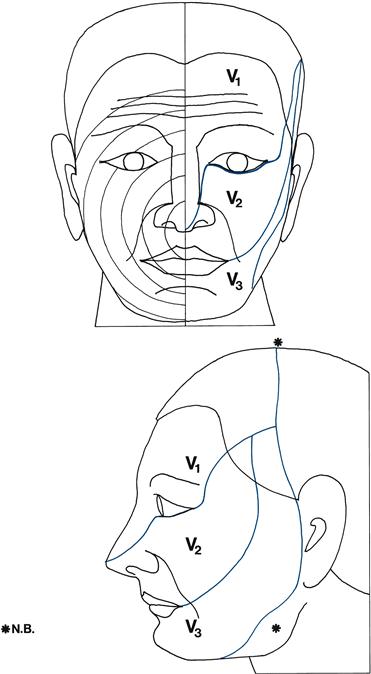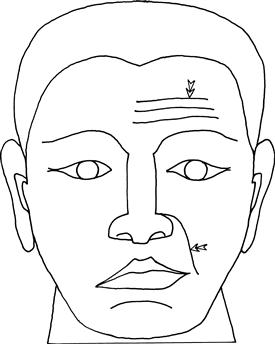Cranial Nerves V and VII
The Face
BACKGROUND
Facial nerve: VII
Peripheral function can be summarised as ‘face, ear, taste, tear’:
With lower motor neurone (LMN) facial weakness, all muscles are affected.
With upper motor neurone (UMN) facial weakness, the forehead is relatively preserved.
Trigeminal nerve: V
Motor
The trigeminal nerve supplies the muscles of mastication.
What to do
Look at the face generally.
FACIAL NERVE: WHAT TO DO
Look at the symmetry of the face.
Ask the patient to:
• show you his teeth (demonstrate)
• whistle
• close his eyes tightly as if he had soap in them (demonstrate)
– assess the strength by trying to open his eyes with your fingers
Look out for symmetrical movement.
Compare the strength of the forehead and lower face.
In LMN lesions you can see the eye turn upwards on attempted closure—Bell’s phenomenon.
Other functions of the facial nerve
Look at the external auditory meatus—the cutaneous distribution of VII. Note any vesicles suggestive of herpes zoster.
Provides taste to the anterior two-thirds of tongue. Taste is rarely tested and requires saline solution and sugar solution. A cotton bud is dipped in the solution and applied to the tongue and the patient is asked to identify it. Test each side of the anterior two-thirds and the posterior one-third.
FACIAL NERVE: WHAT YOU FIND
See Figure 11.3.

Figure 11.3 Flow chart: facial nerve abnormalities
Bilateral facial nerve weakness can be easily missed unless tested for. Think of it if you feel that a patient seems impassive when you talk to him. He may not be depressed; his face might not be able to move!
Failure of the patient to smile when asked to whistle has been noted in patients with emotional paralysis due to parkinsonism: the ‘whistle–smile’ sign.
FACIAL NERVE: WHAT IT MEANS
TRIGEMINAL NERVE: WHAT TO DO
Motor
Test muscles of mastication (trigeminal nerve: motor)
Look at the side of the face.
Ask the patient to clench his teeth.
Ask the patient to push his mouth open against your hand.
Jaw jerk.
Sensory
Test facial sensation (trigeminal nerve: sensory). (See Chapter 19 for general comments on sensory testing.)
Test light touch and pinprick in each division on both sides:
TRIGEMINAL NERVE: WHAT YOU FIND
Sensory
• Impairment or loss in one or more divisions on one side (Fig. 11.1): of light touch or pinprick and temperature or both.
• Unilateral facial loss: one or all modalities.
• Muzzle loss of pinprick and temperature.
• Unilateral area of sensory loss not in distribution of whole division.
N.B.
TRIGEMINAL NERVE: WHAT IT MEANS
• Loss of all modalities in one or more divisions:
– Lesion in sensory ganglion: most commonly herpes zoster.
• Loss of sensation in all divisions in all modalities:
– With ipsilateral hemisensory loss of light touch: contralateral parietal lobe lesion.








